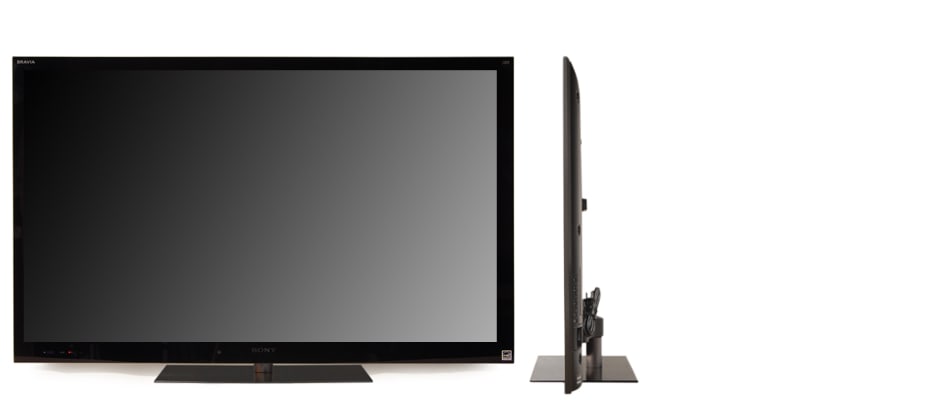Introduction
Overall Design
{{section_header}}{{section.name}}{{/section_header}}
It's hard to see from the vanity shot we have here, but there is a beautiful piece of Gorilla Glass, the front piece of many modern media devices like iPads and smart phones, that fits over the screen and the bezel. Gorilla Glass is more transparent and much stronger than typical screen coverings. When this television is turned off, it appears to have no bezel, being one solid piece of shiny black material. There is a bezel however, when you turn this TV on, about an inch of black wraps around the picture underneath the Gorilla Glass. It looks great, much like the awe inspiring Monolith, depicted here:

Sony actually uses the term "Monolithic Design" to describe the theme of the XBR-HX929 series. The rest of the design is solid as well. The LED lighting keeps the profile very thin and the stand is made of that brushed metal that just makes us smile.
Front
{{section_header}}{{section.name}}{{/section_header}}

Back
{{section_header}}{{section.name}}{{/section_header}}

Sides
{{section_header}}{{section.name}}{{/section_header}}

Stand/Mount
{{section_header}}{{section.name}}{{/section_header}}
We prefer a small stand. A large block of plastic doesn't look nice and can actually distract from viewing. This tight little brushed metal affair is small, thin, and stays out of the way. It's certainly sturdy though, each of the small pieces are made of heavily dense metals and will keep the large display in place. There is also some motion in the neck, allowing the television to swivel about 20º in either direction for easy access to the ports.
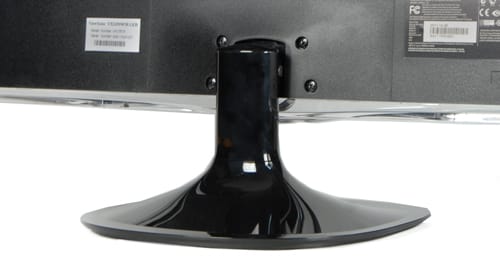
Controls
{{section_header}}{{section.name}}{{/section_header}}
Preserving the monolithic blackness of the display are manual controls. If you had fancy touch controls on the front, like many modern designs, your beautiful black display would end up with smudges all over, like a bunch of apes had been petting it to evolve into tool users.
The controls on the side are easy to distinguish by touch, have great key travel, and they are out of the way so you don't have to look at them. The extra button at the bottom works as a secondary on/off switch. It is called the Energy Save Mode because when you turn off the television this way, it will no longer save any presets, like clock times or picture settings, thus reducing the standby power consumption to essentially zero.

Remote Control
{{section_header}}{{section.name}}{{/section_header}}
The {{product.name}}'s remote control is a great example of industrial design. The buttons are arranged intuitively and each of them has a great feel and shape. There is a backlight button at the top that glows so you can find what you need in the dark. There are hot keys at the top to access online content like Netflix, Qriocity and the i-Manual, as well as TrackID, a smart TV function we love.
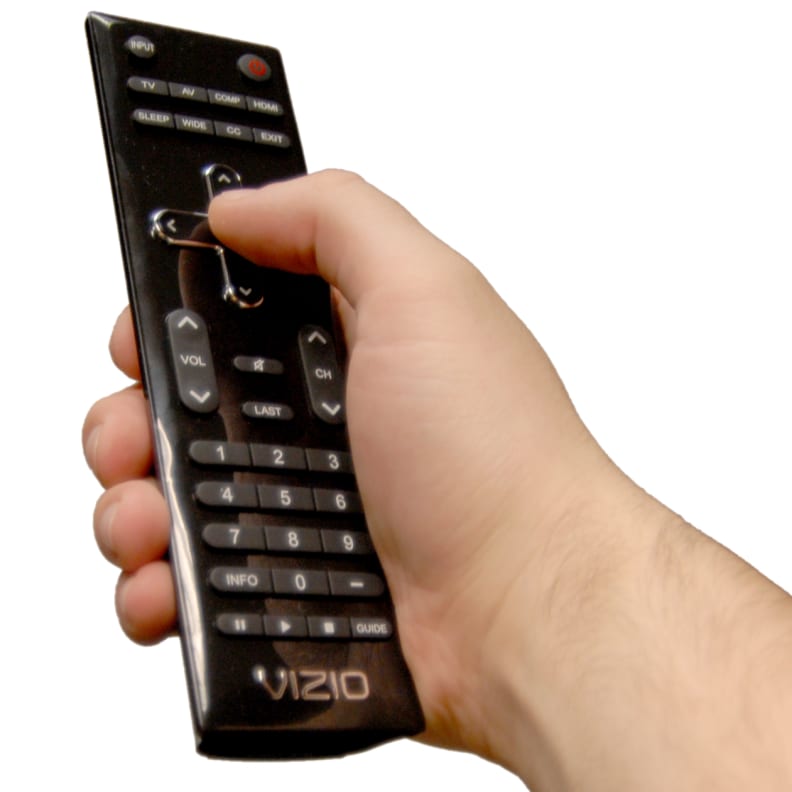
In the Box
{{section_header}}{{section.name}}{{/section_header}}
If you open a box for a {{product.model}}, you will find a TV, a remote, three parts to a shiny little stand, some batteries, a paper manual, several warranties and warnings, an adapter for analog ports, and the joy of owning a new television.
Black Level
{{section_header}}{{section.name}}{{/section_header}}
LCD screens cannot get as dark as plasma ones. A measurement of 0.08 cd/m2 isn't great for deepest black level, it's really not bad either. You won't be disappointed. More on how we test black level.
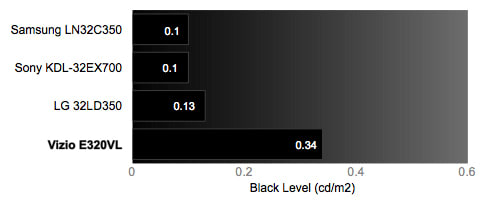
Peak Brightness
{{section_header}}{{section.name}}{{/section_header}}
This Sony one of the brightest models we have tested. With the backlight set to max, this screen outshined the competition handily. In fact, in the Calibration Section we say you could probably knock the backlight down a little if you want to get a deeper black level and avoid some of the flashlighting that we will discuss further down this page. More on how we test peak brightness.
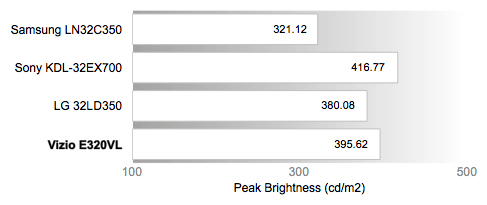
Contrast
{{section_header}}{{section.name}}{{/section_header}}
With such a high peak brightness, the {{product.model}} has a great range of blacks and whites which translates into a fantastic contrast ratio. Each one of the models in the chart is a performer and this Sony competes with some of the best in contrast ratio.
One of the few unique features of the xxHX929 series is full-array local dimming, where the screen is broken up into 105 zones that adjust the backlight according to what is on the screen. If there is a bright fireball flying across a deep blue sky, the zones will brighten when the fireball passes, and dim when there is just sky to display. We turn these functions off to test contrast because they affect the peak brightness and the black level artificially. In fact, we do not support the technology anyway. Only using 105 zones is not enough detail to accurately dim or brighten images that use over 2,000,000 pixels in the 1080 HD format. Generally, you will notice that an area around bright moving objects will also be brightened. From the example, parts of the sky will be brighter than others, though it should be a ubiquitous swatch of dark blue. More on how we test contrast.
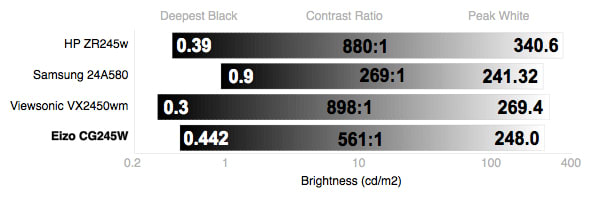
Tunnel Contrast
{{section_header}}{{section.name}}{{/section_header}}
We test to see if a television artificially dims the screen depending on the images shown. If this is the case, the contrast ratio is slightly spurious because the deepest black will only be displayed when most of the screen is black. So, we change the area of the screen displaying black and test the luminance at the center to see if any dimming occurs.
You can see there is a little hill and valley right when the screen becomes 60% filled by black, but it's not enough to notice. The {{product.model}} stays consistently dark no matter how much of the screen displays pure black. More on how we test tunnel contrast.
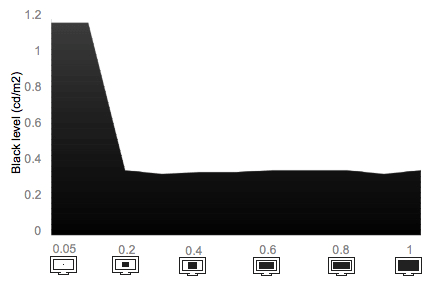
White Falloff
{{section_header}}{{section.name}}{{/section_header}}
The straight horizontal line of this chart shows that no matter how much of the screen shows white (the opposite of the previous test) the brightness stays consistent, right around 400 cd/m2. More on how we test white falloff.
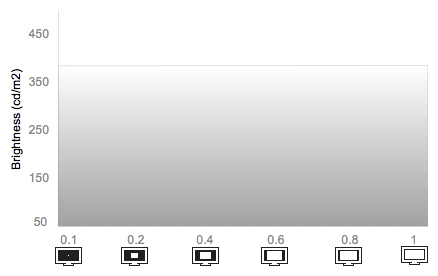
Uniformity
Greyscale Gamma
{{section_header}}{{section.name}}{{/section_header}}
The grayscale graph demonstrates a television's ability to transition from one value of gray to another from 0 to 255. If you see bumps, these are values that could not be properly produced, places where banding will occur. Mostly this line is very smooth, meaning each value has an individual level of brightness that will show a smooth change from dark to light in a gradient.
The line should be completely straight from left to right, sloping at 2.15, +/- .05. The beginning of the graph has some difficulty, showing inconsistency in the darkest values, but it straightens out beautifully at a medium dark gray. The line is a little steep however, 2.61 is outside the acceptable range, meaning that the transitions happen to quickly. Each value will be different, but each value is too bright for what it is supposed to be.
Overall, a decent show of value transitioning, using the full range of the strong contrast ratio. You will be happy with the black and white performance on the {{product.model}}. More on how we test greyscale gamma.
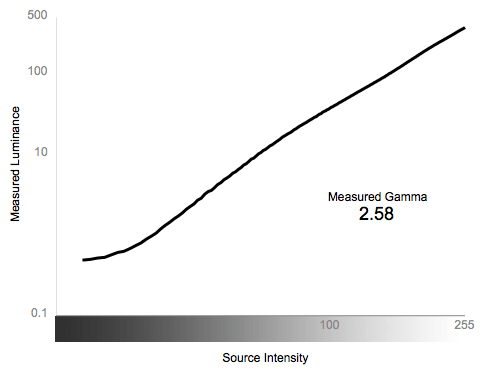
Color Temperature
{{section_header}}{{section.name}}{{/section_header}}
This is the kind of beautiful color temperature we like to see. There is very little variation off of the ideal. Any temperature difference away from the center line at 0 in the chart below will start to show tinting of either warm or cool color. None of the little peaks are large enough for people to be able to tell a difference, so the colors will remain untinted at every luminance level. More on how we test color temperature.
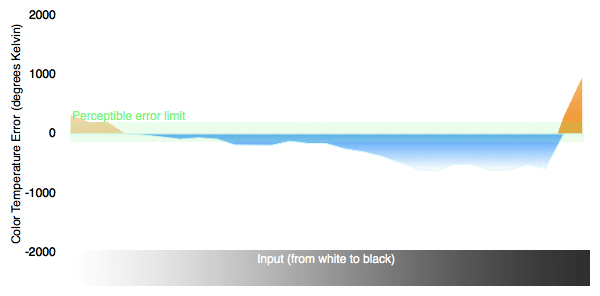
RGB Curves
{{section_header}}{{section.name}}{{/section_header}}
The color curves in the chart below look great. The curve of the lines is exactly what we hope to see. It demonstrates a consistently increasing luminance along the spectrum from dark to light such that one color value is predictably different from the next. There are no bumps in the line, meaning each of the input values were properly produced. The lines do not peak early, so the brightest colors will still have detail instead of being a wash.
You can notice that the three lines do not quite overlap. The overlap would show that all the colors get brighter at the same rate. There is some oversaturation in the reds, and a little undersaturation in the blues, but they are close enough to each other that it's not too important. More on how we test RGB curves.
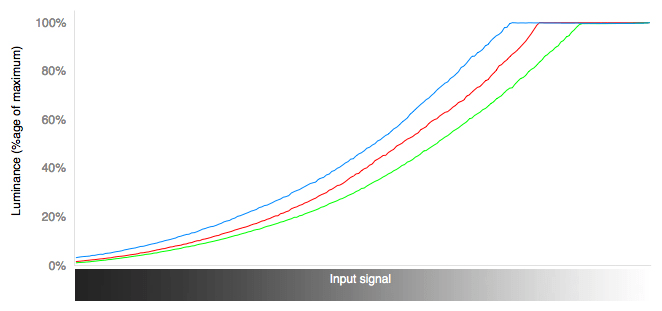
The strips below show one vertical line of pixels for each of the luminance inputs from 0 to 255. They are graphical views of the chart you see above. The smooth transition of colors is the most notable aspect of the {{product.name}} bars compared to the other models that have banding in some parts along the spectrum.
Motion Performance
{{section_header}}{{section.name}}{{/section_header}}
This Sony display has an impressive starting refresh rate of 240 HZ. Additionally, there are two motion processing modes on the {{product.name}}, CineMotion and Motionflow. With these combined, Sony claims refresh rates up to 960fps, which is a bit of an illusion. The baseline refresh rate of 240 HZ is strong, and with these extra features interpolating frames between frames, the refresh rate is artificially enhanced. That the rate is enhanced up to the quality of some future technology able to refresh at 960 HZ natively, we are skeptical, but these processing functions play well to our tests. We turned both of these modes on to test motion and we saw a strong performance.
We move a photo back and forth across the screen to test how well a television can handle objects in motion. This photo has a variety of heavily detailed aspects, like cornice work with tight lines on an angle, other photographs in the background, and a person's face in the foreground. All of these are difficult for televisions to move accurately, given the angles and level of detail that will need to be refreshed perfectly as the photo moves. Each one of these details was starkly retained in motion, the face did not blur, the photographs in the background were recognizable and the lines on the cornice work stayed separate.
Detail retention was great, but we saw some slight artifacting. Artifacts are creations of the television that are not part of the intended signal. Artifacts result from an inability to replicate a difficult signal. There were some slight jagged edges to all the patterns, and some distortion to the rectangular frame of all the objects. None of this was severe. The worst of it, the jaggies and shape distortion, displaying on our high frequency, high contrast pattern, the most difficult part of the test.
We do advise you probably do not want to watch content with the motion processing features engaged. You will notice that images become overly smooth, almost unreal looking. Some people like it for sports games, but mostly you will agree that the picture just looks wrong with so much interpolation. More on how we test motion performance.
3:2 Pulldown & 24fps
{{section_header}}{{section.name}}{{/section_header}}
In the CineMotion menu, Sony explains that CineMotion 2 is intended for film based content, like what we test in our 24fps test. With this function engaged, we saw no difference than when it was left off. There was some flickering and juddering to the picture at 24fps. There seems to be no real way to accurately show film based content on this Sony. We will say that on Off or CineMtion 2 was better than on CineMotion 1, which caused more flickering and juddering. More on how we test 3:2 pulldown and 24fps.
Resolution Scaling
{{section_header}}{{section.name}}{{/section_header}}
The {{product.name}} displays natively at 1080p, but only the highest quality HD content shows at this resolution. Mostly, you will see 720p and some 480p. Below we detail how well the internal processor handles these other resolutions.
Something to note: We had to make two adjustments to be able to free the screen of overscan clipping problems. In the Home menu, under settings, picture and display settings, then the screen menu, there are two sections: Wide Mode and Display. Set Wide Mode to Full, and Display to Full Pixel and you will not have overscan. More on how we test resolution scaling.
480p
Somehow there was no overscan moving from a 16:9 aspect ratio to a 4:3. We assume that some clipping must occur from changing from widescreen to standard, but this Sony handled it without a second thought. With no overscan, all of the patterns and the text were wonderfully rendered.
720p
The {{product.model}} could not accurately display a handful of moire patterns. Rather than producing tightly stitched lines and pixel patterns, many of these were banded together. Our highest frequency pattern in another test banded as well. Intricate detail will be hard to display at 720p.
3D Effect & Experience
{{section_header}}{{section.name}}{{/section_header}}
We tend to notice that 3D images these days are either unwatchable or not that 3D. The images can be unwatchable because the objects that project out of the screen are so unbelievable, suffer from so much crosstalk, and the difference between the plane of the television and where we are supposed to focus our eyes contradicts enough to cause severe eyestrain. The alternative is that the 3D depth is reduced, free of physical pain and brain confusion, but just not that 3D.
With our subjective judgement, developed from having experienced all the 3D systems across the television market, we would like to say that the 3D on the {{product.name}} was one of the best we have seen. The {{product.name}} uses active shutter 3D glasses to display full HD 3D images. These images fell in the less depth category, and we think this is the best option of the two. Crosstalk was noticeably absent from most images and we did not experience the discomfort that we expect to endure when testing 3D. The depth was not great, but objects were certainly arranged in front and behind one another in space. 3D is still so new, and like anything, it is best to start small and work your way up from there. We appreciate that Sony is taking baby steps into the 3D realm, rather than jumping all the way in and hoping to correct backwards from there.
If you would like to learn more about 3D technology as it stands right now, Here is an excellent article by the Editor in Chief of TelevisionInfo.com.
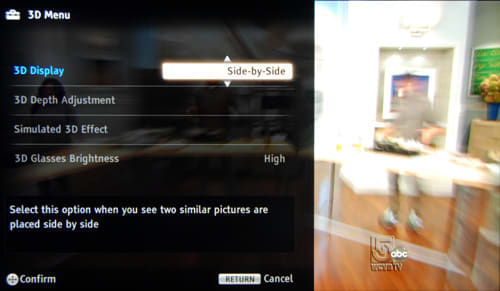
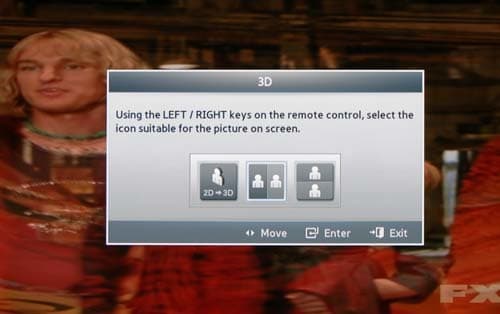
Some of the options in the 3D menu
3D Black & White
{{section_header}}{{section.name}}{{/section_header}}
The {{product.name}} maintains a strong contrast ratio when displaying 3D. Often, the peak brightness is completely ruined by wearing the 3D glasses. The lens of the glasses are dark, so any light coming in is heavily dimmed. This Sony gets so bright that the dimness of the lens did not hamper the brightness, and the extra darkness made a better black level, thus preserving a strong overall contrast ratio. Also, knowing that dimmed glasses cause problems for black and white values, we set the 3D glasses mode to Bright in the 3D menu. A contrast ratio over 1000:1 is good, especially in 3D, and this Sony outperforms this standard by a long shot.

3D Color
{{section_header}}{{section.name}}{{/section_header}}
In 3D, the {{product.model}} had problems with color temperature. You can see in the chart that throughout the spectrum, the temperature is noticeably cool. There will be an overall blue tinting to images that stays consistent at all brightnesses.
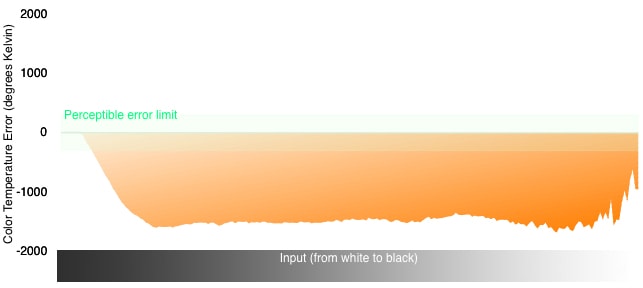
We saw some great color curves in 3D. Frequently we see heavy amounts of processing on the luminance of colors in 3D, probably to make up for a huge loss of brightness caused by wearing dark 3D glasses. We can tell processing occurs when we see huge jumps in the color curves, where the separation of one value from the next is drastic. Companies do this to ensure a difference can be seen on the screen, but it eliminates the possibility of seeing a smooth transition, which helps make a beautiful picture. The {{product.model}} did not have brightness issues in 3D. As a result, this TV was able to produce these three beautifully curved, smooth, contiguous lines, representing 255 values of brightness for each of the three primary colors.
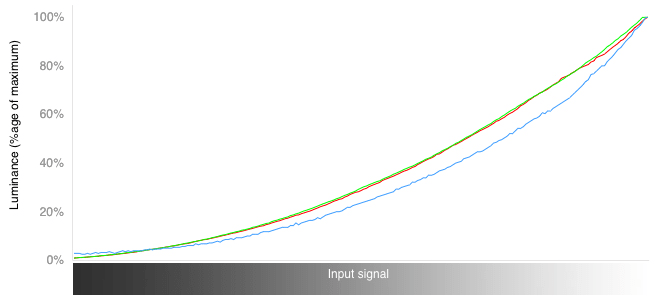
Not too far from the original color gamut produced in 2D, the 3D gamut shows us that the colors are consistent when switching between the two modes. This information, taken with the quality of the color curves, shows a really great 3D color performance out of this Sony.
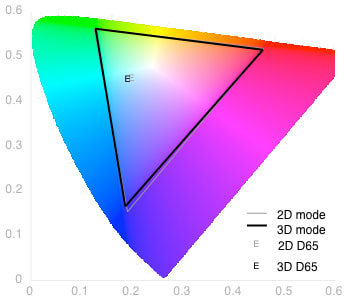
3D Crosstalk
{{section_header}}{{section.name}}{{/section_header}}
Our crosstalk data shows that when the color black is against any other color, images intended for one eye will slip into the other. In 3D, images are to remain separate, a unique picture for each eye, a process called Stereoscopy. When an image for the left eye shows up in the right, or vice versa, the 3D image becomes more 2D, a result of crosstalk. Black had some large slippage, but the rest of the colors remained separate, even gray values, which are known as the most difficult for crosstalk.
When watching a 3D movie, we saw very little crosstalk. Even black values were not that bad, probably because most images never use pure black. Pure black is the color of a screen deactivated, which usually only happens when transitioning from scene to scene. Black clothes will generally have some light values to them, making them actually dark gray. Since the gray crosstalk data was not bad, the crosstalk visually with "black" was not very noticeable either. Overall, this Sony did a great job keeping images separate. You will not see the haloing that causes a breakdown of 3D immersion that you see in most 3D TVs.
3D Glasses
{{section_header}}{{section.name}}{{/section_header}}
Luckily we have a stash of Sony 3D glasses on hand, otherwise watching 3D would require a further purchase of at the very least $50/person. Sony does not include any glasses in the box, even though the TV costs over $2000. This is really a kick in the pants of the consumer willing to dedicate enough money to the Sony brand, when other brands will give you a pair of glasses to start, with the purchase of a TV. We suspect that the "3D Craze" trumpeted by the media and marketing executives, is a way to get you to buy a whole bunch of expensive accessories in addition to a TV.
Despite the extra price, these glasses work well. They are not as clunky as some of last years models, or of competing brands. They can be very sensitive though. If your head angles or you look away for a moment, the active shutters turn off. They will reengage when you enter the sensor area again, but the area is narrow such that standing up or changing your seating position may put you outside the range.
We could see the flickering of the active glasses when we weren't wearing them. Like a strobe light hitting each of your eyes separately, we can't imagine such an experience is healthy. Testing for health issues usually takes years, no one has done such testing yet. In fact, we, the collective 3D consumers of the world, are the guinea pigs. Most 3D movies are 3D animated movies intended for a very young audience, an audience with developing eyes and visual cortices. Here is an excerpt from a Samsung issued health warning that has since been removed from the Samsung website (raise any eyebrows?), parts of which can still be read Here: "If you experience any of the following symptoms, stop viewing 3D pictures immediately and consult a medical specialist:
*altered vision
*lightheadedness
*dizziness
*involuntary movements such as eye or muscle twitching
*confusion
*nausea
*loss of awareness
*convulsions
*cramps
*disorientation
Children and teenagers may be more likely than adults to experience these symptoms. Parents should monitor their children and ask whether they are experiencing these symptoms."
If there is even a possibility of "altered vision" that will more likely affect younger people than adults, as described by the producers of 3D technology. Do you think this is a good idea for your kids?
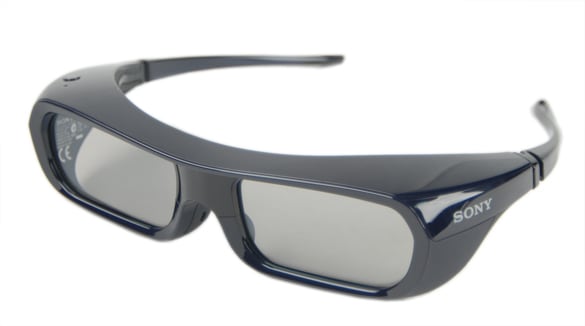
Yes, you will look like a dork with these on
Formats
{{section_header}}{{section.name}}{{/section_header}}
The {{product.name}} displays natively at 1080p and accepts all NTSC formats.
Viewing Angle
{{section_header}}{{section.name}}{{/section_header}}
The viewing angle chart below is demonstrative of the limitations of twisted nematic LCD displays. You can see that four different televisions using the same display technology are confined to narrow viewing angles. Though the color performance and contrast ratios are superb, viewing a twisted nematic display off center will detract from these strong points of picture quality.
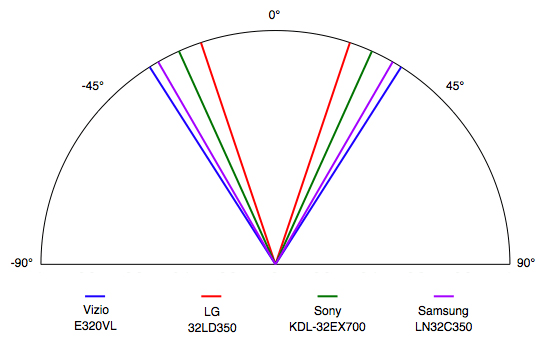
Reflectance
{{section_header}}{{section.name}}{{/section_header}}
The screen was so bright that lights shined at the screen were not very noticeable. A 100 Watt bulb, with no covering, emits approximately 120 cd/m2, so if this television's peak brightness is more than 400 cd/m2, you would have to have an intense set of lights to compete with this Sony's screen.
Nevertheless, we shined some bright LED lights right at the screen and saw that it was not distracting. The light reflection was dispersed into a rainbow pattern, meaning that the display has the ability break reflected light into its component parts, dispersing some of the original intensity in reflection.
External lights will not be a problem with the {{product.model}}, but the extreme flashlighting created by the internal lighting units will be. Take a look at the Uniformity Section to read a detailed diatribe about the flashlighting.
Video Processing
{{section_header}}{{section.name}}{{/section_header}}
There are so many video processing features on this flagship Sony. They are located in three different menus, so good luck finding them. Many of them we had a hard time distinguishing between on and off.
Calibration
{{section_header}}{{section.name}}{{/section_header}}
We calibrated the {{product.name}} according to a standard we set for all televisions. Using DisplayMate software, we set every television to maximum brightness and adjust the contrast, brightness, color, sharpness and whatever other options there are, to match international guidelines.
For this particular model, the peak brightness was so high, and the flashlighting of the backlights was so unforgivably abominable, we can recommend that you decrease the backlight to a comfortable level. You will still be able to watch this Sony in any lighting situation and the calibration we set in the table below will be accurate for the colors and the black and white values.

All of our calibration is done in conjunction with the DisplayMate software.
](http://www.displaymate.com/)
Video Modes
{{section_header}}{{section.name}}{{/section_header}}
The following table is a list of the pre-programmed video calibrations on the {{product.name}}.
Connectivity
{{section_header}}{{section.name}}{{/section_header}}
This Sony has declared analog to be obsolete. There are no analog connections to get in the way of four HDMI ports, a PC connection and two USB ports. The shedding of the analog ports actually makes this set of connections sleek and accessible. It is a bold move to do away with analog, but it is the next logical step. There is an adapter port however that connects to both a composite and a component video, but only one at a time. If you have older devices, you will need to throw them out immediately. According to Sony, you live in the stone age.
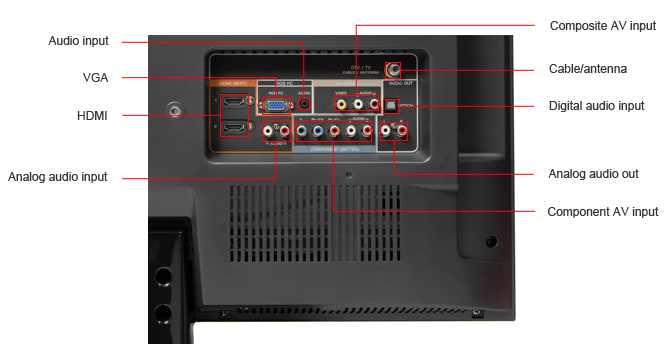
The adapter connection is actually quite clever. This bar of analog coaxial inputs is easily removable from the televisions. You could leave your analog machine connected to the adapter, and only have to plug in one HDMI-like cord to link the two.
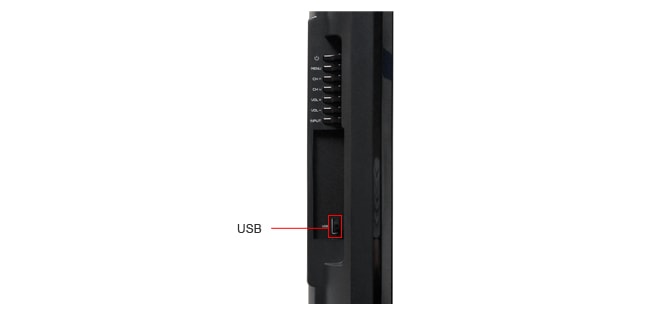
Placement
{{section_header}}{{section.name}}{{/section_header}}
The ports are located on an L-shaped cutout on the left, back side of the display. Given the lack of analog ports, the layout is beautifully arranged and well-spaced for easy connecting. The stand swivels 20º in either direction as well, so plugging and unplugging will be a breeze.
Audio Quality
{{section_header}}{{section.name}}{{/section_header}}
Usually the simulated surround modes on televisions create an echoic and slightly enriched soundscape for a sad impression of the cinematic experience. We recommend you engage these modes when watching movies, especially those with explosions. However, they do not usually trick us into thinking there are speakers around the room. We always suggest that you get a Dolby 5.1 setup in your house if you want some actual sound quality, especially when television speakers output at only 10W.
With the {{product.name}}, you get an extra 10W coming from a small sub woofer to help the sound output, but more important is the engineering going into the Surround mode. These simulated surround modes work by bouncing the sound waves off the walls to make it seem like sound is coming from all around you. The Sony engineers have done some excellent tweaking of this process. We noticed that elements on the screen corresponded to the sounds around us, for example the sound of a missile launch from off-screen traveled from behind, to above, and then onto the screen.
We were impressed, but yet we wonder who would buy a television for more than $2,000 and be satisfied with simulated surround, when a decent sound system would only be a few hundred dollars more. Probably no one, but at the same time, we must give props where props are due.
Menu Interface
{{section_header}}{{section.name}}{{/section_header}}
Oh man their menus are awful, notoriously awful. Read consumer reviews elsewhere and you will see hordes of posts about this sloppy and confusing interface. Since last year, Sony has gone from winning awards for menu interface, to this unwieldy collection you see here. Our guess is that with the massive increase of online content coming to TVs, Sony hasn't yet figured out how to present it all coherently. We imagine next year will show some improvements that you may be able to get from a simple software update, rather than buying a new set. Although, that sounds too good to be true.
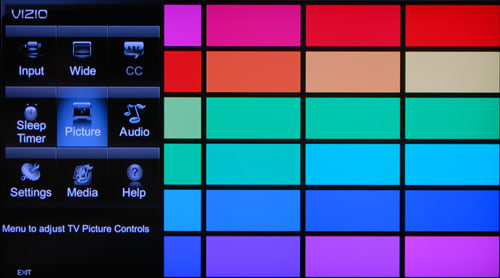
To get to the picture settings you have to do the following steps. Start by finding settings in the Home menu.

Then you find Picture Adjustments in the Picture and Display Menu.
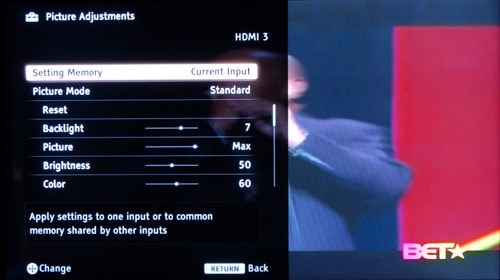
Only then can you get the actual settings to change the picture calibration. Each one of these menus is different from the one that proceeds it. It is a hunt to find what should be readily accessible adjustments to the TV you own. Sometimes features, like 3D adjustments, are in a useful menu, which is only accessible once you enable a feature in a completely different menu.
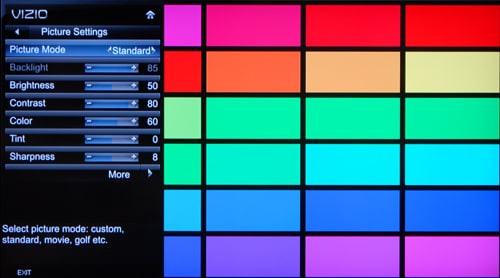
Instruction Manual
{{section_header}}{{section.name}}{{/section_header}}
There are two manuals for most new Sony televisions. A small paper setup guide and the "i-Manual". We found neither to be that helpful. The setup guide covers assembling the stand, general connections and a small amount of hardware troubleshooting.
The "i-Manual" is accessible both through the TV, within the jungle of menus, or online at Sony Support. The "i-Manual" is not searchable, and suffers from some of the same problems as the menu interface. The organization is not great, you may have to look in several places before you find the help you need. Furthermore, some features are excluded, such as the RS-232C port and accompanying IR Rerouter in the back of this Sony.
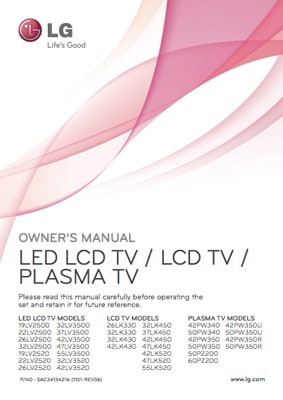
A manual for so many TV models, they have to be further categorized by type.
Internet Features
{{section_header}}{{section.name}}{{/section_header}}
Sony does not organize the wealth of DLNA very well. There is a menu for Widgets...
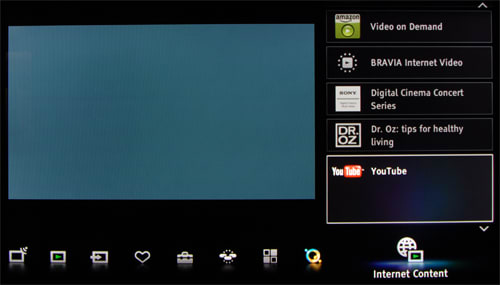
...a menu for Apps...

...a menu for Qriocity, Sony's bank of streaming content...
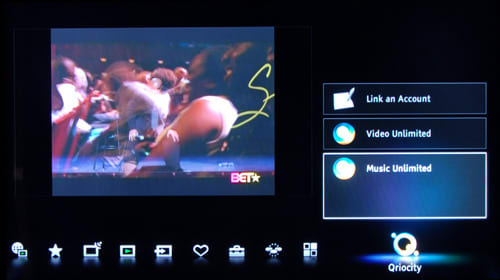
...and a menu for Online Content. Apps, Widgets, and online content are all the same thing, unless you are on a mobile phone, and then the difference is very slight. An excerpt from DifferenceBetween.com: "The major difference between widgets and apps is that widgets can be run automatically from the home screen of your mobile without having to make a call", essentially allowing a user to access the internet without detracting from his or her data plan. This is not something that applies to the streaming content on a television and therefore confuses us as to why Sony chose these titles. It's like an old person using slang they don't understand to try and stay "jiggy" with it.
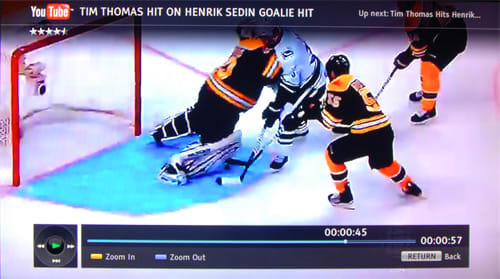
The YouTube playback is a wonderful thing.
At first glance, Online Content seems to be a collection of all the premium streaming partners, like Hulu, Netflix and Amazon Instant Video, but the Billabong Network and the NHL Vault are definitely not at the forefront of streaming popularity.
All of these options work rather well fortunately, so if the confusion of where to find them doesn't bother you, a strongly capable smart TV awaits. The one exception to this is the internet browser. It just isn't worth anyone's time. It is slow and you have to use a the D-Pad on the remote to type in URLs or select any link on a page. You probably have a smart phone or an iPad handy if you are trying to buy a $2,500 television, so use those to get on the internet instead.
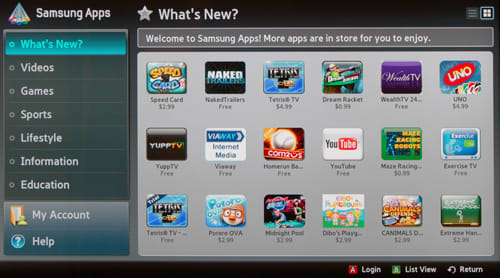
There are also plenty of games to download, free and paid, new and classic
Local Media Playback
{{section_header}}{{section.name}}{{/section_header}}
When you plug in a USB device, a message on the screen alerts you that media content is available. You can access it from the Home menu with a bit of effort. Many different types of video, photo and music are playable, although we found that quite a few standard formats that work fine on a computer cannot be displayed on this Sony (the manual in the link on the side bar of this page has a complete list of acceptable formats).
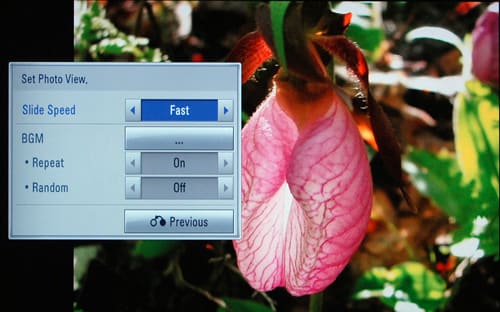
There are not too many options for creating great slideshows. One drawback that always bothers us is the inability to enlarge a picture. What you see below is a fantastic depiction of an ape, as a man, yet it will remain only a small square of brilliance in an otherwise very dark screen. Make sure you explore all of the options available to you by pressing the "Options" button on the remote. Otherwise, you will be helplessly searching through a gaggle of boggling menus for a way to play your photos in a succession to your liking.
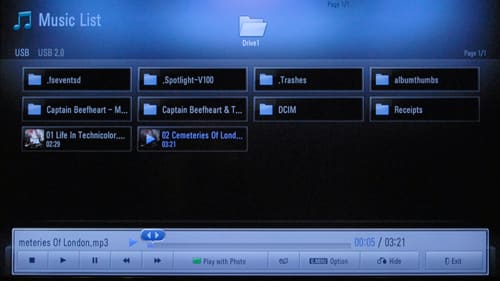
Other Media
{{section_header}}{{section.name}}{{/section_header}}
There are no other media features on this television.
Power Consumption
{{section_header}}{{section.name}}{{/section_header}}
For an average year of television consumption, you will not have to pay too much for the {{product.name}}. We also recommend that you can crank the backlight down a little, because the screen gets so bright at maximum. Furthermore, there is the Energy Save button on the right side of the display where the manual controls reside. If you use this button to turn off your TV, the power consumption in standby mode is as close to zero watts as possible. Be aware, however, that you will lose any presets like the television's internal clock.
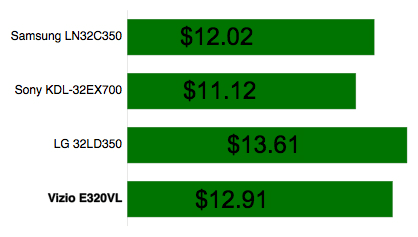
Value Comparison
{{section_header}}{{section.name}}{{/section_header}}
These two TVs are comparable high-end models from top brands. These two sets have the same features and are approximately the same price, but the Toshiba doesn't hold up in any performance category. This should be a pretty easy decision for most consumers, unless you have the kind of brand loyalty that you get from cigarettes.
Blacks & Whites
{{section_header}}{{section.name}}{{/section_header}}
The contrast ratio on the Sony is twice as good as the Toshiba, beating it out in black level and peak brightness.

Color Accuracy
{{section_header}}{{section.name}}{{/section_header}}
The Sony had a near perfect color temperature where the Toshiba had slight problems. The color curves on the Toshiba looked a little ridiculous, the colors were uneven and jumpy. The Sony had strong curves and is a better color producer than the Toshiba.
Motion
{{section_header}}{{section.name}}{{/section_header}}
For top-quality, the Toshiba did not move objects smoothly across the screen. With CineMotion and MotionFlow technologies, the Sony showed great retention of detail with moving objects, thus explaining the difference in the motion scores for these two televisions.
Viewing Effects
{{section_header}}{{section.name}}{{/section_header}}
The viewing angles are so similar that you would probably not notice the difference.
Connectivity
{{section_header}}{{section.name}}{{/section_header}}
The Toshiba seems to have no analog options, where the Sony offers them through an adapter cord that comes in the box with purchase.
Other Comparisons
{{section_header}}{{section.name}}{{/section_header}}
Both televisions had flashlighting issues where the backlighting showed strongly through the display during dark sequences.
We were unable to test the 3D on the Toshiba, but felt that the 3D experience on the Sony was very strong.
Value Comparison
{{section_header}}{{section.name}}{{/section_header}}
Here we compare two TVs in the Sony 2011 line, the XBR-HX929 and the KDL-HX729. The HX929 is the top Sony model, and the HX729 is an upper-mid-range television. The features list is almost identical as provided by Sony Insider. The only difference we can see is that the HX929 series has a Monolithic Design, meaning the sleek Gorilla Glass over the front and bezel, and the full-array local dimming. Local dimming changes the brightness of the picture in 105 different zones in a matrix across the screen to increase the difference between the light and dark values for a stronger contrast ratio. We turn this function off during testing because it affects the outcome of the black level tests. Furthermore, 105 zones on this top-of-the-line Sony puts the brand at the bottom of the pack for local dimming, with Samsung, Sharp, and LG ahead. The best of these brands use almost 300 dimming zones to more concisely adjust the picture brightness.
If sleek design and the industry's worst local dimming are worth about $1000 to you, then you should consider the HX929. Otherwise, our testing showed that these two televisions are essentially identical. You can get the same machine for a lot less with the HX729.
Blacks & Whites
{{section_header}}{{section.name}}{{/section_header}}
The HX729 had a slightly better contrast ratio, but a difference this small will not be noticeable when watching content.

Color Accuracy
{{section_header}}{{section.name}}{{/section_header}}
The color temperatures were similarly on target, the HX729 seeming to be slightly less aberrant. The color curve score, which is generated by an automated test, was identical.
Motion
{{section_header}}{{section.name}}{{/section_header}}
Both of these TVs have the same motion processing capabilities, CineMotion and MotionFlow to get up to the supposed 960fps. This test is slightly subjective and varies between testers. The scores are so close they might as well be same.
Viewing Effects
{{section_header}}{{section.name}}{{/section_header}}
Here we can see that the viewing angles of all these comparable LCD models are more or less equal.
Connectivity
{{section_header}}{{section.name}}{{/section_header}}
The connectivity options are the same. They both have access to the same online media and the same menu system.
Value Comparison
{{section_header}}{{section.name}}{{/section_header}}
This comparison is between the top Samsung model and the top Sony model for 2011. Both are really great TVs, with substantial price tags. The performance on both sides is great, but we've seen better on each brand's mid-range models, or their plasma alternatives, for less money.
If you are considering one of these two top models, we like the Samsung. Though uniformity was a problem for both the Samsung and the Sony, due to fancy LED edgelighting, the flashlighting on the Sony was beyond excuse, whereas you will be able to live with the blotchy spots on the Samsung. Online features are part of the reason these sets are so expensive. The Sony menu systems are an exercise in tribulation. The Samsung Smart Hub is the most organized and intuitive interface of the year. If you are paying this much money you should not be hampered by whacky menus and a foggy picture, both of which can be avoided by buying Samsung.
Blacks & Whites
{{section_header}}{{section.name}}{{/section_header}}
The Samsung had one of the best contrast ratios of the year. It is hard to beat. The Sony was very strong in this category as well, you can't go wrong with either TV.

Color Accuracy
{{section_header}}{{section.name}}{{/section_header}}
Though the error is not great, the whites on the Samsung are too warm for a long stretch of the signal intensity. No such problems on the Sony, it stays consistent around zero throughout the spectrum. The Sony had better color curves, meaning a better use of the range of each primary color from dark to light.
Motion
{{section_header}}{{section.name}}{{/section_header}}
Though Sony has great motion processing overdrive features, Samsung does as well. Sony motion engineering is the best this year, and the motion trophy goes to the {{product.model}}.
Viewing Effects
{{section_header}}{{section.name}}{{/section_header}}
The viewing angles are so similar as to be insignificantly different.
Connectivity
{{section_header}}{{section.name}}{{/section_header}}
Samsung has not yet done away with analog ports. If you have a few older devices, you will want these included ports to connect them. The {{product.name}} has an adapter for old devices, but you can only have one plugged in at a time.
Conclusion
The {{product.model}} ($2,500 MSRP) is the high-end Sony smart television from 2011, displaying 1080p natively. With 3D and internet capabilities, this TV is top of its class. Consider the performance on our tests, and it's competing for one of the best of the year.
The contrast ratio was grand, stemming from one of the highest peak brightnesses we have seen on a TV this year. The color accuracy was near exact, matching up reasonably with any other top model from this year. The motion processing was strong as well, using two different processing modes to achieve refresh rates of 960Hz, according to Sony. The 3D didn't make us sick immediately and the online offerings were overwhelmingly vast.
Here is the part where we undercut all of the benefits, phrased as a message to Sony: If you are trying to make a great television, you should ensure that the simplest aspects are taken care of first. Then, you can put in the high end performance that will make it top-of-the-line. If you have a great contrast ratio and spectacular colors, it doesn't matter much if there are giant cloudy halos shining through all of the corners of the screen. Seriously, the flashlighting was egregious and inexcusable. Consumers will be upset about spending this much on a TV, only to come home to see large and obvious cloudy patches taking up much of the picture. Furthermore, if you want to provide all of the most advanced processing and online features, start with an intuitive menu system. Plenty of content that is hard to access is the same as a great picture you can't see. Lastly, the 3D was not as sickening, but neither was it as 3D. We appreciated that our eyes and brains were spared the ache, but consumers serious about experiencing 3D at home may be disappointed with the lack of 3D depth on this Sony.
We can see serious gamers enjoying this television for its motion, color, brightness, and black & white performances. But if these gamers ever wanted to watch a Clint Eastwood movie, or something similar with a lot of shadows, they will bemoan the day they spent a small fortune on this Sony.
Model Series Comparison
{{section_header}}{{section.name}}{{/section_header}}
Each of the three sizes in the xxHX929 series, the 46'', 55'', and 65'' display at 1080p, are 3D ready (meaning no included 3D glasses), and can connect to a host of online content. There are two media ports, that play some photos, music, and videos, but check the i-Manual for a complete list of supported formats. On the back of each of these panels is a connection to an RS-232C port so you can control your television from an external computer, you AV nerd.
The xxHX929 series comes with so many processing features it would be easy to switch some of them on, and then get lost in what the original picture should look like. Two motion processing modes, CineMotion and MotionFlow interpolate a 240 Hz display up to 960fps, but we remain skeptical on this marketing claim.
Photo Gallery
{{photo_gallery "Front Tour Image", "Back Tour Image", "Sides Tour Image", "Stand Photo", "Controls Photo", "Remote Control Photo", "Connectivity Tour Image 1", "Connectivity Tour Image 2", "Connectivity Extra Photo", "Menu Main Photo", "Menu 2 Photo", "Internet Features 1 Photo", "Internet Features 2 Photo", "Internet Features 3 Photo", "Local Media Playback 1 Photo", "Local Media Playback 2 Photo"}}
Ratings & Specs
{{manufacturer_specs_table}}
Meet the tester
Christian Sherden is a valued contributor to the Reviewed.com family of sites.
Checking our work.
Our team is here to help you buy the best stuff and love what you own. Our writers, editors, and experts obsess over the products we cover to make sure you're confident and satisfied. Have a different opinion about something we recommend? Email us and we'll compare notes.
Shoot us an email